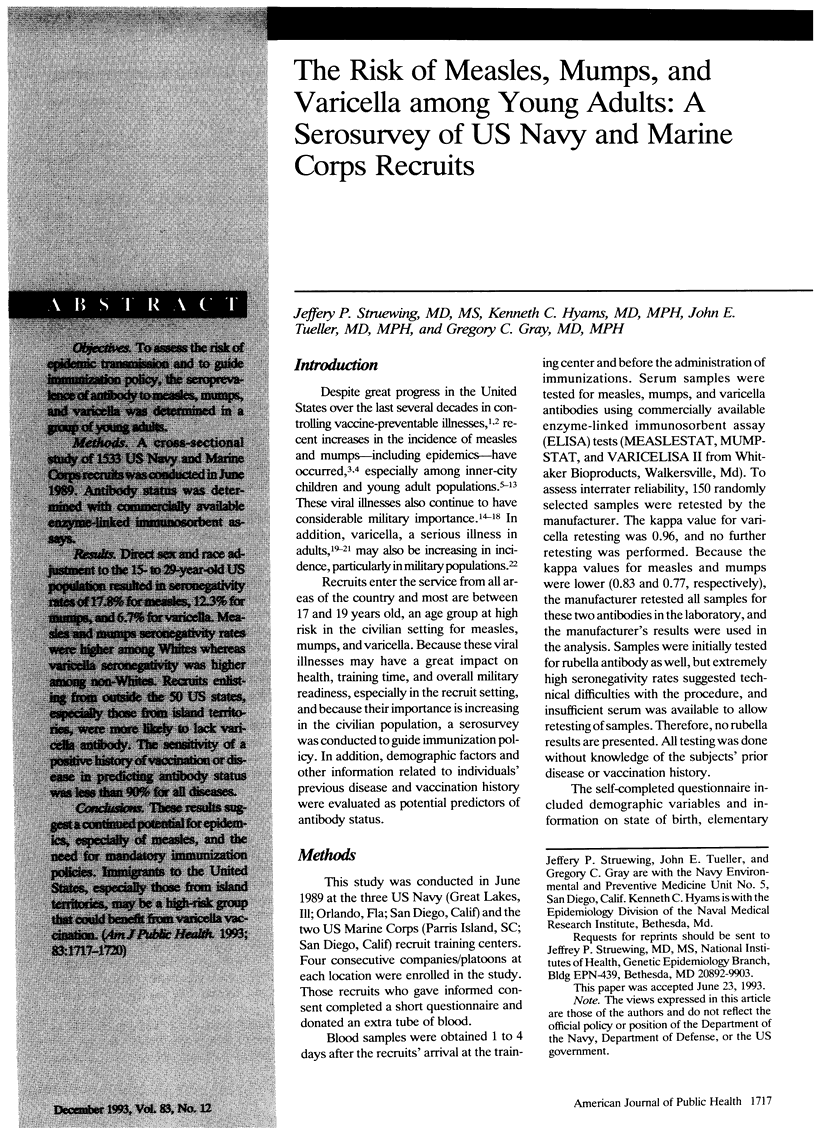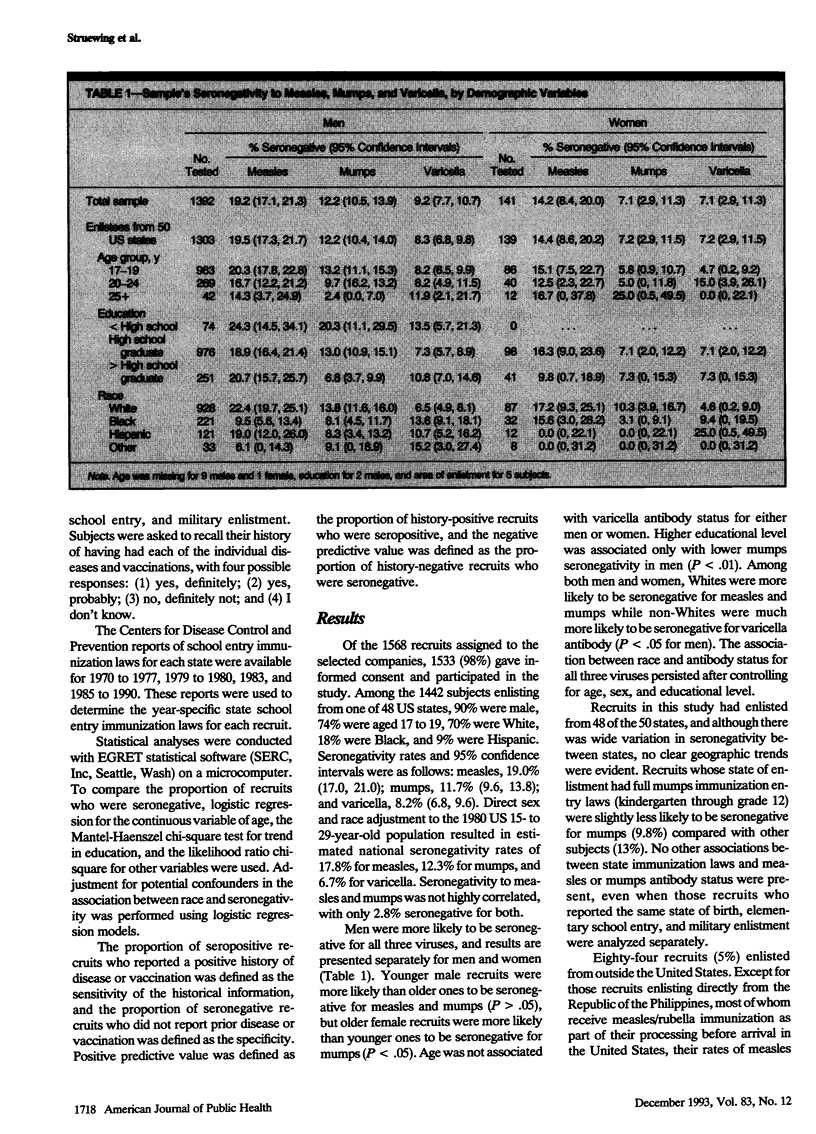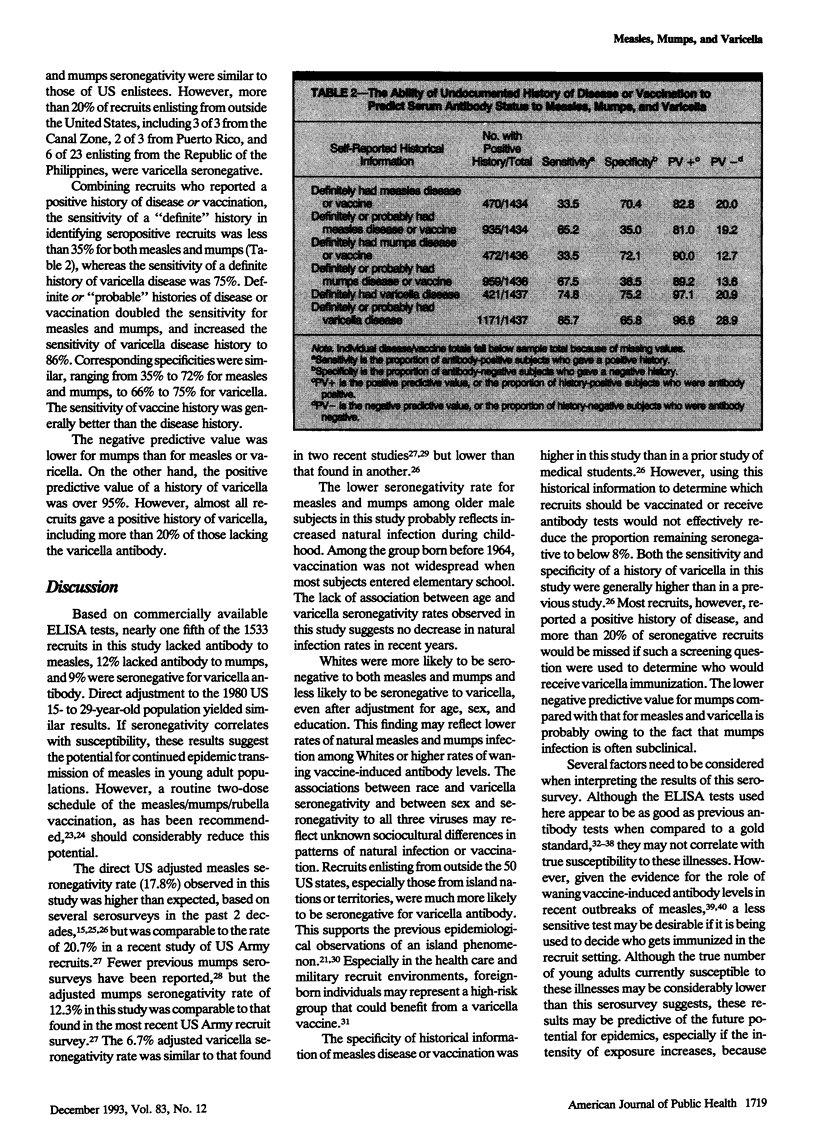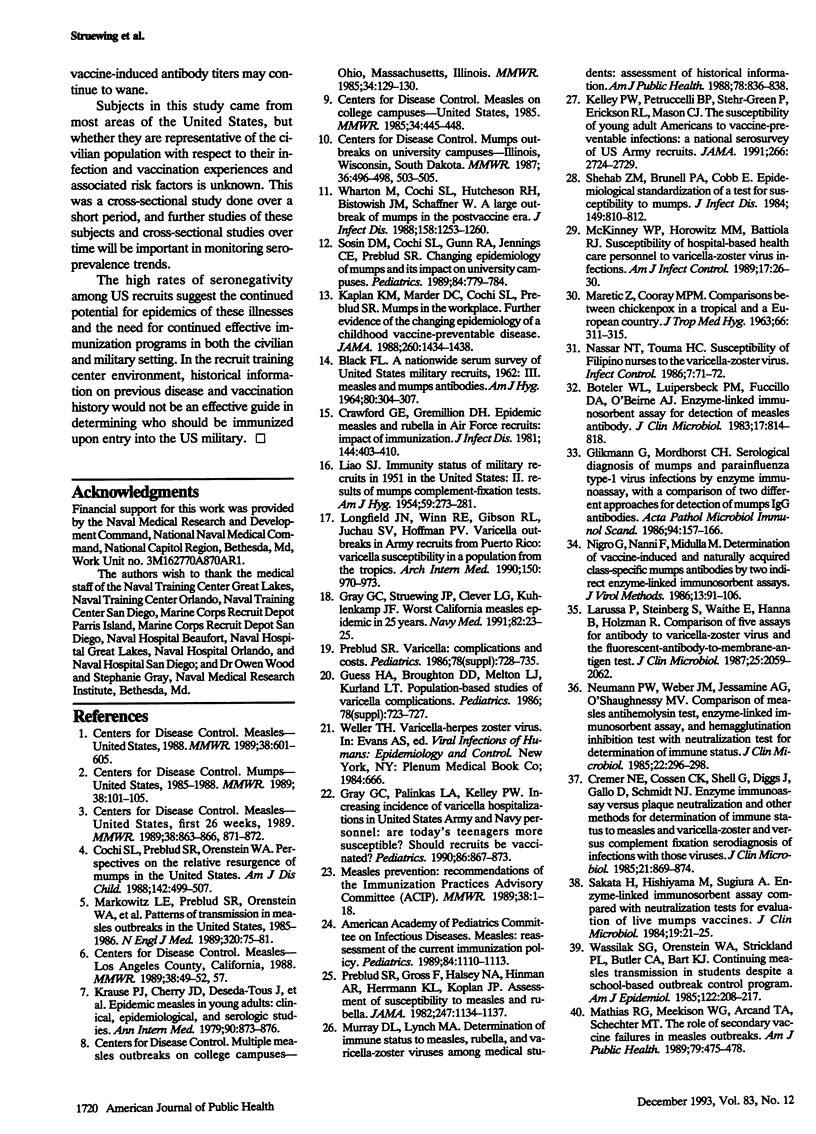Abstract
OBJECTIVES. To assess the risk of epidemic transmission and to guide immunization policy, the seroprevalence of antibody to measles, mumps, and varicella was determined in a group of young adults. METHODS. A cross-sectional study of 1533 US Navy and Marine Corps recruits was conducted in June 1989. Antibody status was determined with commercially available enzyme-linked immunosorbent assays. RESULTS. Direct sex and race adjustment to the 15- to 29-year-old US population resulted in seronegativity rates of 17.8% for measles, 12.3% for mumps, and 6.7% for varicella. Measles and mumps seronegativity rates were higher among Whites whereas varicella seronegativity was higher among non-Whites. Recruits enlisting from outside the 50 US states, especially those from island territories, were more likely to lack varicella antibody. The sensitivity of a positive history of vaccination or disease in predicting antibody status was less than 90% for all diseases. CONCLUSIONS. These results suggest a continued potential for epidemics, especially of measles, and the need for mandatory immunization policies. Immigrants to the United States, especially those from island territories, may be a high-risk group that could benefit from varicella vaccination.
Full text
PDF



Selected References
These references are in PubMed. This may not be the complete list of references from this article.
- BLACK F. L. A NATIONWIDE SERUM SURVEY OF UNITED STATES MILITARY RECRUITS, 1962. 3. MEASLES AND MUMPS ANTIBODIES. Am J Hyg. 1964 Nov;80:304–307. doi: 10.1093/oxfordjournals.aje.a120479. [DOI] [PubMed] [Google Scholar]
- Boteler W. L., Luipersbeck P. M., Fuccillo D. A., O'Beirne A. J. Enzyme-linked immunosorbent assay for detection of measles antibody. J Clin Microbiol. 1983 May;17(5):814–818. doi: 10.1128/jcm.17.5.814-818.1983. [DOI] [PMC free article] [PubMed] [Google Scholar]
- Cochi S. L., Preblud S. R., Orenstein W. A. Perspectives on the relative resurgence of mumps in the United States. Am J Dis Child. 1988 May;142(5):499–507. doi: 10.1001/archpedi.1988.02150050037025. [DOI] [PubMed] [Google Scholar]
- Crawford G. E., Gremillion D. H. Epidemic measles and rubella in air force recruits: impact of immunization. J Infect Dis. 1981 Nov;144(5):403–410. doi: 10.1093/infdis/144.5.403. [DOI] [PubMed] [Google Scholar]
- Cremer N. E., Cossen C. K., Shell G., Diggs J., Gallo D., Schmidt N. J. Enzyme immunoassay versus plaque neutralization and other methods for determination of immune status to measles and varicella-zoster viruses and versus complement fixation for serodiagnosis of infections with those viruses. J Clin Microbiol. 1985 Jun;21(6):869–874. doi: 10.1128/jcm.21.6.869-874.1985. [DOI] [PMC free article] [PubMed] [Google Scholar]
- Glikmann G., Mordhorst C. H. Serological diagnosis of mumps and parainfluenza type-1 virus infections by enzyme immunoassay, with a comparison of two different approaches for detection of mumps IgG antibodies. Acta Pathol Microbiol Immunol Scand C. 1986 Aug;94(4):157–166. doi: 10.1111/j.1699-0463.1986.tb02105.x. [DOI] [PubMed] [Google Scholar]
- Gray G. C., Palinkas L. A., Kelley P. W. Increasing incidence of varicella hospitalizations in United States Army and Navy personnel: are today's teenagers more susceptible? Should recruits be vaccinated? Pediatrics. 1990 Dec;86(6):867–873. [PubMed] [Google Scholar]
- Guess H. A., Broughton D. D., Melton L. J., 3rd, Kurland L. T. Population-based studies of varicella complications. Pediatrics. 1986 Oct;78(4 Pt 2):723–727. [PubMed] [Google Scholar]
- Kaplan K. M., Marder D. C., Cochi S. L., Preblud S. R. Mumps in the workplace. Further evidence of the changing epidemiology of a childhood vaccine-preventable disease. JAMA. 1988 Sep 9;260(10):1434–1438. doi: 10.1001/jama.260.10.1434. [DOI] [PubMed] [Google Scholar]
- Kelley P. W., Petruccelli B. P., Stehr-Green P., Erickson R. L., Mason C. J. The susceptibility of young adult Americans to vaccine-preventable infections. A national serosurvey of US Army recruits. JAMA. 1991 Nov 20;266(19):2724–2729. [PubMed] [Google Scholar]
- Krause P. J., Cherry J. D., Deseda-Tous J., Champion J. G., Strassburg M., Sullivan C., Spencer M. J., Bryson Y. J., Welliver R. C., Boyer K. M. Epidemic measles in young adults. Clinical, epidemiologic, and serologic studies. Ann Intern Med. 1979 Jun;90(6):873–876. doi: 10.7326/0003-4819-90-6-873. [DOI] [PubMed] [Google Scholar]
- LIAO S. J., BENENSON A. S. Immunity status of military recruits in 1951 in the United States. II. Results of mumps complement-fixation tests. Am J Hyg. 1954 May;59(3):273–281. doi: 10.1093/oxfordjournals.aje.a119640. [DOI] [PubMed] [Google Scholar]
- Larussa P., Steinberg S., Waithe E., Hanna B., Holzman R. Comparison of five assays for antibody to varicella-zoster virus and the fluorescent-antibody-to-membrane-antigen test. J Clin Microbiol. 1987 Nov;25(11):2059–2062. doi: 10.1128/jcm.25.11.2059-2062.1987. [DOI] [PMC free article] [PubMed] [Google Scholar]
- Longfield J. N., Winn R. E., Gibson R. L., Juchau S. V., Hoffman P. V. Varicella outbreaks in Army recruits from Puerto Rico. Varicella susceptibility in a population from the tropics. Arch Intern Med. 1990 May;150(5):970–973. [PubMed] [Google Scholar]
- MARETIC Z., COORAY M. P. COMPARISONS BETWEEN CHICKENPOX IN A TROPICAL AND A EUROPEAN COUNTRY. J Trop Med Hyg. 1963 Dec;66:311–315. [PubMed] [Google Scholar]
- Markowitz L. E., Preblud S. R., Orenstein W. A., Rovira E. Z., Adams N. C., Hawkins C. E., Hinman A. R. Patterns of transmission in measles outbreaks in the United States, 1985-1986. N Engl J Med. 1989 Jan 12;320(2):75–81. doi: 10.1056/NEJM198901123200202. [DOI] [PubMed] [Google Scholar]
- Mathias R. G., Meekison W. G., Arcand T. A., Schechter M. T. The role of secondary vaccine failures in measles outbreaks. Am J Public Health. 1989 Apr;79(4):475–478. doi: 10.2105/ajph.79.4.475. [DOI] [PMC free article] [PubMed] [Google Scholar]
- McKinney W. P., Horowitz M. M., Battiola R. J. Susceptibility of hospital-based health care personnel to varicella-zoster virus infections. Am J Infect Control. 1989 Feb;17(1):26–30. doi: 10.1016/s0196-6553(89)80009-4. [DOI] [PubMed] [Google Scholar]
- Murray D. L., Lynch M. A. Determination of immune status to measles, rubella, and varicella-zoster viruses among medical students: assessment of historical information. Am J Public Health. 1988 Jul;78(7):836–838. doi: 10.2105/ajph.78.7.836. [DOI] [PMC free article] [PubMed] [Google Scholar]
- Nassar N. T., Touma H. C. Brief report: susceptibility of Filipino nurses to the varicella-zoster virus. Infect Control. 1986 Feb;7(2):71–72. doi: 10.1017/s019594170006392x. [DOI] [PubMed] [Google Scholar]
- Neumann P. W., Weber J. M., Jessamine A. G., O'Shaughnessy M. V. Comparison of measles antihemolysin test, enzyme-linked immunosorbent assay, and hemagglutination inhibition test with neutralization test for determination of immune status. J Clin Microbiol. 1985 Aug;22(2):296–298. doi: 10.1128/jcm.22.2.296-298.1985. [DOI] [PMC free article] [PubMed] [Google Scholar]
- Nigro G., Nanni F., Midulla M. Determination of vaccine-induced and naturally acquired class-specific mumps antibodies by two indirect enzyme-linked immunosorbent assays. J Virol Methods. 1986 May;13(2):91–106. doi: 10.1016/0166-0934(86)90077-7. [DOI] [PubMed] [Google Scholar]
- Preblud S. R., Gross F., Halsey N. A., Hinman A. R., Herrmann K. L., Koplan J. P. Assessment of susceptibility to measles and rubella. JAMA. 1982 Feb 26;247(8):1134–1137. [PubMed] [Google Scholar]
- Preblud S. R. Varicella: complications and costs. Pediatrics. 1986 Oct;78(4 Pt 2):728–735. [PubMed] [Google Scholar]
- Sakata H., Hishiyama M., Sugiura A. Enzyme-linked immunosorbent assay compared with neutralization tests for evaluation of live mumps vaccines. J Clin Microbiol. 1984 Jan;19(1):21–25. doi: 10.1128/jcm.19.1.21-25.1984. [DOI] [PMC free article] [PubMed] [Google Scholar]
- Shehab Z. M., Brunell P. A., Cobb E. Epidemiological standardization of a test for susceptibility to mumps. J Infect Dis. 1984 May;149(5):810–812. doi: 10.1093/infdis/149.5.810. [DOI] [PubMed] [Google Scholar]
- Sosin D. M., Cochi S. L., Gunn R. A., Jennings C. E., Preblud S. R. Changing epidemiology of mumps and its impact on university campuses. Pediatrics. 1989 Nov;84(5):779–784. [PubMed] [Google Scholar]
- Wassilak S. G., Orenstein W. A., Strickland P. L., Butler C. A., Bart K. J. Continuing measles transmission in students despite school-based outbreak control program. Am J Epidemiol. 1985 Aug;122(2):208–217. doi: 10.1093/oxfordjournals.aje.a114091. [DOI] [PubMed] [Google Scholar]
- Wharton M., Cochi S. L., Hutcheson R. H., Bistowish J. M., Schaffner W. A large outbreak of mumps in the postvaccine era. J Infect Dis. 1988 Dec;158(6):1253–1260. doi: 10.1093/infdis/158.6.1253. [DOI] [PubMed] [Google Scholar]


